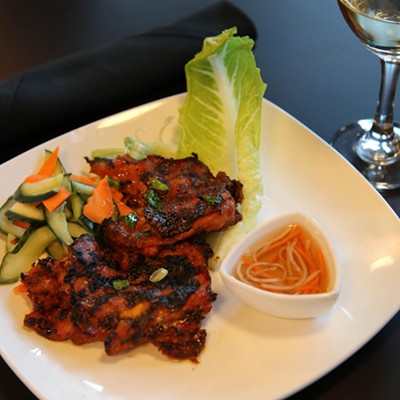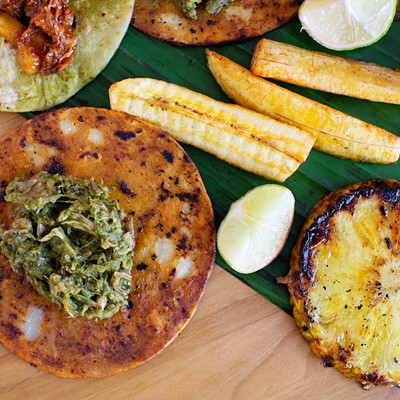Diceable, sliceable, cooked or not, the daikon on your plate one place may be slightly sweet, but crunchy and caliente somewhere else. It can be used as a garnish, in salads, soups and stews, as a solid vegetable side or an edible decoration. Japanese daikon looks like a rough, white carrot on steroids, has the crunchy firmness of a newly dug potato and will vary in size. Korem daikon tends to be smaller and darker. You can find both in most produce sections and always at the 17th Street Farmers' Market.
My favorite Japanese daikon comes as part of a simple and elegant tableau: Shredded in long, curly strings, it's presented as the waves and surf behind the sliced albacore tatake at Sushi Gardens (15 N. Alvernon Way). Sushi Chef Soichi Seki sometimes adds a tree carved from a carrot to the backdrop, sprinkles a little grated garlic and jalapeno over the seared tuna and splashes it all with a tangy soy-garlic sauce. This is a tough dish to share--if you are not dining alone, order more than one. On the other hand, the garlic-and-jalapeno "zest" is definitely not everyone's fave. Soichi says that Sushi Garden's clients can consume up to 40 pounds of albacore a week. Soichi, by the way, has a lot of fans.
Tatake is, simply, tuna which has been seared. It usually means blue-tail, yellow-tail, albacore (another white meat) or big-eye tuna. The belly meat--toro--is the fattiest cut. Research will tell you that "chu-toro" is the pinkish tuna of "middle" fattiness, and that the red "maguro" or ahi is probably most familiar to Westerners. Maguro is said to be the first raw fish that most Westerners try, because they say it tastes like rare steak. That may be so, but I've never had a steak tartare that is as good on your tongue as is raw tuna.
The shredded form of daikon re-appears in Sushi Chef Gin's tatake presentation at Sushi Saga (3117 E. Speedway Blvd.). Once again, the tuna has been quickly seared, sliced and bedded on lacy daikon and presented with a homemade ginger-and-garlic dipping sauce. "Yellow-tail is better because it is not so oily," Gin says, unlike blue-tail which is "very, very rich." His personal favorite is big-eye, because it has a lot of flavor. To Gin, there's either toro--the belly side--or the flavorful portion on the back behind the head of the fish. He makes a fine, fine dish
As is the tatake at Shabu, Shabu Tanaka (5605 E. River Road). It isn't prominently on the menu, but Mr. Tanaka happily prepares it as an elegant side offering to his regular entrées. Here, the daikon is shaped into little florets sprinkled on the thinly sliced wafers of seared albacore. Shabu, Shabu means "swish, swish"--the hand/wrist/chopsticks action you take when doing your own cooking in the pan of bubbling broth in front of you.
The hands-down best tatake I have ever had was on a recent chilly night. Pay attention, because this is a handy guide to a heavenly delight you can make for yourself.
Every Wednesday (and sometimes more often), the aforementioned 17th Street Market gets a shipment of fresh fish. My friend Alec, of Finnish extraction by way of Iowa and Santa Fe, thinks of the 17th Street Market as a kind of shrine to healthy eating and healthy living. In addition to being my massage therapist, he has me on a regimen of herbs, teas and tinctures which both promote good health and ensure a consistent physical routine every morning in just the act of capping and uncapping a dozen different containers.
A few weeks ago, he asked me to stay for dinner after my massage. On the menu: yellow-tail tatake; miso soup; a salad of field greens, mushrooms, walnuts and oranges; steamed Japanese buns; and a cold, crisp Pinto Grigio. No daikon, but, as you have noticed by now, this is really in praise of tatake. Everything save the wine came from the 17th Street Market.
The tuna had been cut from the fish that morning. As the dressing--garlic, ginger, olive oil (not much), a little soy, a splash of malt vinegar, honey, some cracked pepper, red wine, orange zest--for the salad was being boiled down on the stovetop, Alec deftly reduced the perfect slab of glistening red tuna into a stack of quarter-inch slices, grinding and pressing freshly cracked pepper on each slice. The dressing was spooned into a bowl to cool; the iron skillet ("Best way to get iron into your system," says Michael, our constant companion at these meals) was returned to the stove, a little more olive oil added and the peppered tuna slices dropped quickly into the mixture of hot oil and deglazed dressing. Each slice was there for maybe three seconds, flipped for three more, then removed to the center of a flat, shallow bowl, surrounded by the salad. The dressing was drizzled on cold salad and cooling tuna. The miso--which should NEVER be boiled, according to Mr. Tanaka--was ladled into bowls containing chopped scallions, cubes of tofu and halved shitake mushrooms. (Miso concentrate, by the way, is available at specialty food stores all over town, including G&L Import/Export, Grantstone Market, Kimpo, Moan's and Sun Oriental Markets. There are different grades, consistencies and colors for miso, and the proprietors of most of these shops appreciate their customers taking an interest in learning about the differences.)
But, back to dinner. I opened the wine as Michael pulled the sweet Japanese buns from the highly efficient makeshift steamer--an inverted Pyrex bowl covering the buns on a splatter screen on top of a pot of boiling water. The three of us carried our meal to another room, where we proceeded to sit on pillows on the hardwood floor and eat family-style from the central dish of salad and the seared-and-glazed tatake, as we let the miso cool a bit. We were VERY polite about sharing the tatake--we are good friends, after all--and very satisfied by a meal that was light, fresh, easy and quick to make, savory and filling. We felt so good, in fact, that we bundled up and walked a few blocks to the B-Line Café for fresh coffee and a single-but-enormous shared slice of peach-and-pecan pie. (The B-Line will have its own story in the future.)
Several years ago, I made a New Year's vow to eat only food that was made with love. It worked for awhile--both the food and the love--but then those thoughts and commitments got waylaid in the shuffle and dance of contemporary life and the shifting sands of acquaintance. But it is again a new year and time to renew those vows. I'll let you know how it progresses.








